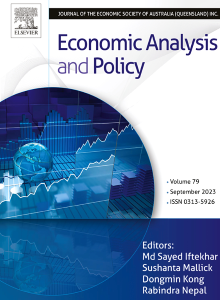Asymmetric nexus of green energy inclusion and green trade spillover effects on economic growth: Insights from China's experience for EAC-6
IF 7.9
2区 经济学
Q1 ECONOMICS
引用次数: 0
Abstract
The quick progress of green energy solutions has led to increased academic focus on their economic consequences. This study provides a comparative study regarding the asymmetric nexus among the novel green energy inclusivity index (IGE), novel green trade spillover effects (GTS), and economic growth. The analysis employed a non-linear autoregressive distributed lagged model (NARDL) and asymmetric causality test using data from 1990 to 2022 in the China and East Africa Community (EAC-6). The findings revealed a pronounced asymmetric convergence across the variables in both countries, with IGE and GTS negative shocks having a stronger impact than positive ones. In insights from China's Experience for EAC, while these results keep robust after conducting quantile regressions and other robust checks, in China both novel green energy inclusivity and novel green trade spillover effects positive shocks have a stronger effect on economic growth than EAC for both short and long terms. Furthermore, the feedback green energy-led growth hypothesis and the feedback green trade spillover effects-led growth hypothesis are confirmed in both countries. As a lesson learned, this study suggests the EAC countries take note of China's emphasis on developing a robust domestic manufacturing and supply chain for renewable energy technologies to potentially enhance more sustainable growth.
求助全文
约1分钟内获得全文
求助全文
来源期刊

Economic Analysis and Policy
ECONOMICS-
CiteScore
9.80
自引率
9.20%
发文量
231
审稿时长
93 days
期刊介绍:
Economic Analysis and Policy (established 1970) publishes articles from all branches of economics with a particular focus on research, theoretical and applied, which has strong policy relevance. The journal also publishes survey articles and empirical replications on key policy issues. Authors are expected to highlight the main insights in a non-technical introduction and in the conclusion.
 求助内容:
求助内容: 应助结果提醒方式:
应助结果提醒方式:


